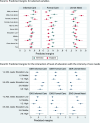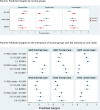Socio-economic differences in receiving care by the over-80s in Germany and England: intensity of care needs as a moderator
- PMID: 40512210
- PMCID: PMC12165915
- DOI: 10.1007/s10433-025-00864-y
Socio-economic differences in receiving care by the over-80s in Germany and England: intensity of care needs as a moderator
Abstract
The growing number of people aged 80 or older living in the community has raised concerns about meeting their care needs and about socio-economic inequalities in their care use. The study examines socio-economic status (SES) patterns in informal and formal care use, as well as unmet care needs, of people aged 80 or older living in the community in Germany and England. We propose that SES patterns in care use change with the intensity of care needs. The analyses use data from the Survey of Quality of Life and Well-Being of the Very Old in North Rhine-Westphalia and the English Longitudinal Study of Ageing. Despite the differences in the long-term care systems (LTCSs) and cultural norms around filial obligations, we find a consistent pattern of association between socio-economic status (SES) and care use for older people with only few care needs in both countries. In this group, people with a higher SES have the highest likelihood of experiencing unmet care needs. For older people with many care needs, we find country-specific SES patterns that we link to cultural differences and the design of the LTCSs. In Germany, SES is negatively associated with using informal care and positively with using formal care. In England, care use shows little SES variation for older people with many care needs. The findings underscore the importance of considering the intensity of care needs when assessing inequalities in care access.
Keywords: Ageing; Care regimes; Formal care; Inequality; Informal care; Unmet care need.
© 2025. The Author(s).
Conflict of interest statement
Declarations. Conflict of interest: The authors declare no competing interests.
Figures




Similar articles
-
Differences in the risk of frailty based on care receipt, unmet care needs and socio-economic inequalities: A longitudinal analysis of the English Longitudinal Study of Ageing.J Frailty Aging. 2025 Apr;14(2):100012. doi: 10.1016/j.tjfa.2025.100012. Epub 2025 Mar 7. J Frailty Aging. 2025. PMID: 40056410 Free PMC article.
-
Gender differences in access to community-based care: a longitudinal analysis of widowhood and living arrangements.Eur J Ageing. 2022 Jul 27;19(4):1339-1350. doi: 10.1007/s10433-022-00717-y. eCollection 2022 Dec. Eur J Ageing. 2022. PMID: 35909811 Free PMC article.
-
Intersecting factors of disadvantage and discrimination and their effect on daily life during the coronavirus pandemic: the CICADA-ME mixed-methods study.Health Soc Care Deliv Res. 2025 Feb;13(2):1-185. doi: 10.3310/KYTF4381. Health Soc Care Deliv Res. 2025. PMID: 39949202
-
A systematic review and meta-analysis of unmet needs for healthcare and long-term care among older people.Health Econ Rev. 2022 Dec 9;12(1):60. doi: 10.1186/s13561-022-00398-4. Health Econ Rev. 2022. PMID: 36482044 Free PMC article.
-
Folic acid supplementation and malaria susceptibility and severity among people taking antifolate antimalarial drugs in endemic areas.Cochrane Database Syst Rev. 2022 Feb 1;2(2022):CD014217. doi: 10.1002/14651858.CD014217. Cochrane Database Syst Rev. 2022. PMID: 36321557 Free PMC article.
References
-
- AgeUK (2019) Briefing: health and care of older people in England 2019. Accessed 29 Jun 2023 at https://www.ageuk.org.uk/globalassets/age-uk/documents/reports-and-publi...
-
- Andersen RM (1995) Revisiting the behavioral model and access to medical care: Does it matter? J Health Soc Behav 36(1):1–10. 10.2307/2137284 - PubMed
-
- Anttonen A, Sipila J (1996) European social care services: Is it possible to identify models? J Eur Soc Policy 6(2):87–100. 10.1177/095892879600600201
-
- Anttonen A, Baldock J, Sipilä J (eds) (2003) The young, the old and the state. Edward Elgar, Cheltenham
Grants and funding
LinkOut - more resources
Full Text Sources

